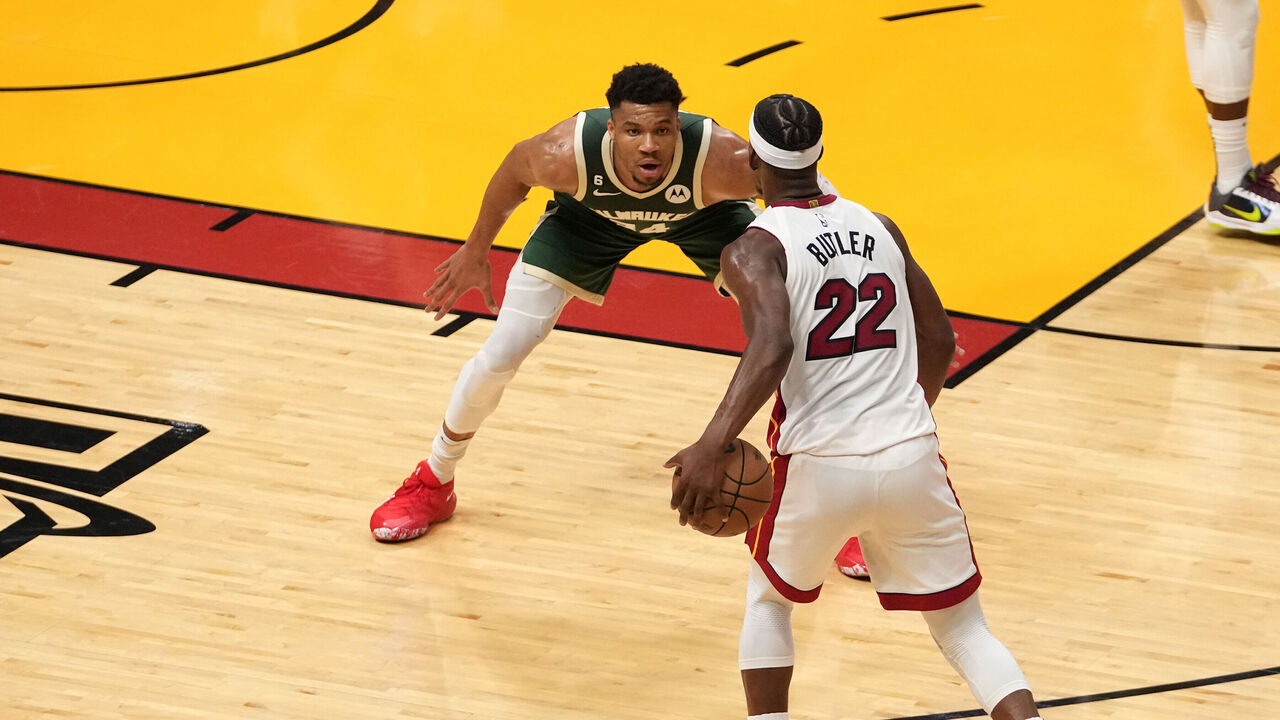Assessing the Bucks' and Grizzlies' chances of coming back from 3-1 down
The early stages of the NBA playoffs aren’t typically conducive to unpredictability. Since the league went to a best-of-seven format in the first round 20 years ago, there have been only four instances of a No. 1 or No. 2 seed failing to reach the conference semis. It hasn’t happened since 2012, when the top-seeded Bulls fell to the eighth-seeded 76ers after losing Derrick Rose to an ACL tear in Game 1.
Fittingly, a 2022-23 season that’s been defined by uncommon league-wide parity has produced an anarchic first round in which not one but two top-two seeds find themselves on the ropes. The Milwaukee Bucks (the No. 1 seed in the East) and Memphis Grizzlies (No. 2 in the West) are down 3-1 to the Miami Heat and Los Angeles Lakers, respectively. Only 13 teams in NBA history have overcome that deficit. So, in a way, all four of those teams are battling history.
Here’s a look at how two teams that barely escaped the play-in have pushed their higher-seeded foes to the brink, and how likely it is that those high seeds can win three straight to advance.
Bucks vs. Heat
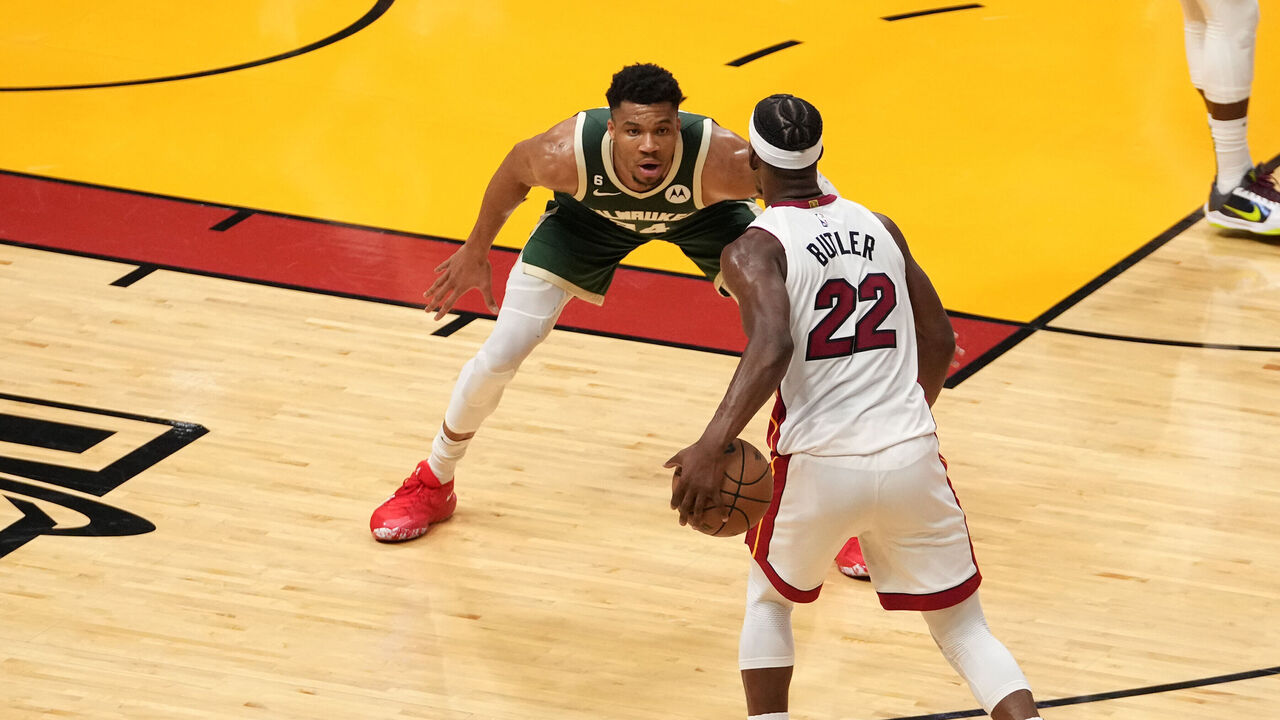
How we got here
Giannis Antetokounmpo missed most of Game 1 and all of Games 2 and 3. He returned for Game 4 with his team in a 2-1 hole, played magnificently, but ran into a Jimmy Butler buzzsaw.
Butler authored one of the greatest individual performances in NBA playoff history Monday night, pouring in 56 points on 19-for-28 shooting in a 119-114 come-from-behind win. For the series, Butler is averaging 36.5 points, 5.5 rebounds, five assists, 1.8 steals, and just 1.8 turnovers while shooting 65% from 2-point range and 53% from deep. He’s scoring 1.29 points per possession as a pick-and-roll ball-handler. All that against a team that’s likely going to have three All-Defensive representatives this season, including a former Defensive Player of the Year, this year’s DPOY runner-up, and the sport’s consensus best perimeter defender.
Nobody on the Bucks has proven remotely capable of slowing him down one-on-one. He’s cooked Jrue Holiday, he’s cooked Khris Middleton, he’s even cooked Antetokounmpo on switches. He’s rained pull-up jumpers against unders and drops, on top of a steady diet of driving layups, burrowing floaters, and bedeviling up-fakes that juke Milwaukee’s imposing bigs in the post.
Holiday is still the Bucks’ best option, so they’ve made a point of trying to maintain that matchup and avoid switching him off. But whether that means playing hedge-and-recover or having Holiday duck under screens, Butler has found the seams in those coverages and exploited them all the same.
The Heat, it should be noted, are shooting a playoff-best 47.6% from 3-point range and have hit over 40% from deep in all four games. This, after ranking 27th during the regular season at 34.4%. They also ranked 25th in overall offensive rating during the season but currently own the most efficient offense in the playoffs at 120.9 points per 100 possessions despite playing without Tyler Herro.
Gabe Vincent, Max Strus, and Kevin Love have all shot the lights out. Caleb Martin and Kyle Lowry have made huge plays at both ends of the floor, especially down the stretch of Game 4. (Lowry’s screening in guard-guard actions with Butler has been instrumental.) Bam Adebayo, despite largely struggling to break through against Brook Lopez offensively, has hit some timely short-roll jumpers and tightened the screws defensively.
Miami has also dusted off Duncan Robinson to serve as an antidote to Milwaukee’s deep drop with his shooting coming off of dribble-handoffs. This has been especially effective (Robinson’s 10-for-13 from deep in the series) with defenders like Middleton and Pat Connaughton frequently getting hung up on screens:

Two weeks ago, the Heat were squeaking past the Bulls in the second and final play-in game after dropping the first one to the Hawks. Now, they’re a win away from bouncing the championship favorites. You’d be inclined to dismiss it as an aberration if Butler hadn’t consistently proven capable of ratcheting up his play (and especially his jump shooting) to previously unseen heights in the playoffs, and of making the impossible feel possible.
Besides, aberration or not, Miami has three cracks at this and only needs to win one more time. One more hot shooting night, one more Butler explosion, or one dominant defensive showing could send the Bucks packing. The Heat are a deeply imperfect team, but they have a proven formula for playoff success, which is basically to defend their tails off, muddy up the game with physicality, and trust Butler to carry their offense. We’ll see if that formula can produce a titanic upset.
Can the Bucks come back?
Surely the Heat can’t keep shooting the ball this well. Right?
Anything can happen in a small sample, of course, but if that shooting does indeed fall off, the Bucks’ myriad advantages are going to shine through. The fact that Antetokounmpo came back from the back contusion he suffered in Game 1 looking scarcely worse for wear was a massive development. He consistently got the Bucks into their offense early, which was an element they sorely missed without him. Through the first three games of the series, they played 84.2% of their possessions in the half court, the most of any playoff team. In Game 4, they brought that down to 76.5%, per Cleaning the Glass.
When they were in the half court, Antetokounmpo’s playmaking kept them humming, especially as the ball-handler in 4-5 pick-and-rolls with Lopez. Whether Miami tried to switch those actions or put two on the ball, Antetokounmpo was able to see over the top and hit Lopez in stride. Putting the Heat’s biggest defenders in the action meant their undersized back-line help had no shot to stop Lopez at the rim:
Lopez also had the option to pop rather than roll; he got three 3-pointers out of that action when Antetokounmpo dragged both defenders with him on the drive. All told, he was the recipient of nine of Antetokounmpo’s 13 assists.
With Giannis back, the Bucks were once again able to access their identity as a jumbo bully-ball team, and they made their size advantage felt for most of Game 4. They won the offensive rebounding battle 16-9 (with Lopez and Antetokounmpo combining to grab 10 of them) and outscored Miami 42-18 at the rim. They just need the jump-shooting math to tilt a bit further their way.
We know Milwaukee is generally reluctant to come out of its base defensive scheme, which affords opponents plenty of opportunities to shoot off the dribble, especially from the mid-range. This season, that scheme has also been pretty help-averse; the Bucks trust their guys to defend in isolation and their pick-and-roll defenders to defend actions two-on-two, and they aim to keep everyone else home to prevent catch-and-shoot threes.
To that end, they’ve done what they intended: 43% of the Heat’s shots in the series have been non-rim 2-pointers compared to just 22% inside the restricted area, and Miami has attempted more pull-up jumpers than any playoff team besides Phoenix. Unfortunately for Milwaukee, thanks largely to Butler’s heroics, Miami is leading the league in mid-range shooting (50.7%) and effective field-goal percentage on pull-ups (61.3%), up from 45.5% and 47.7% during the regular season.
The Bucks might ultimately need to show Butler more bodies, but they can also just clean up some basic mistakes with more attention to detail. You’d think getting torched by one player this badly would get a team particularly keyed in on said player, but the Bucks have still had mystifying lapses where they failed to pick Butler up in semi-transition. Here, they got so lost that Bobby Portis wound up shoving Joe Ingles into Butler for an and-one:
On the play below, no one stepped up to deter Butler after Lowry screened Holiday in the backcourt, allowing Butler to saunter down the court unimpeded before hitting a step-back dagger:
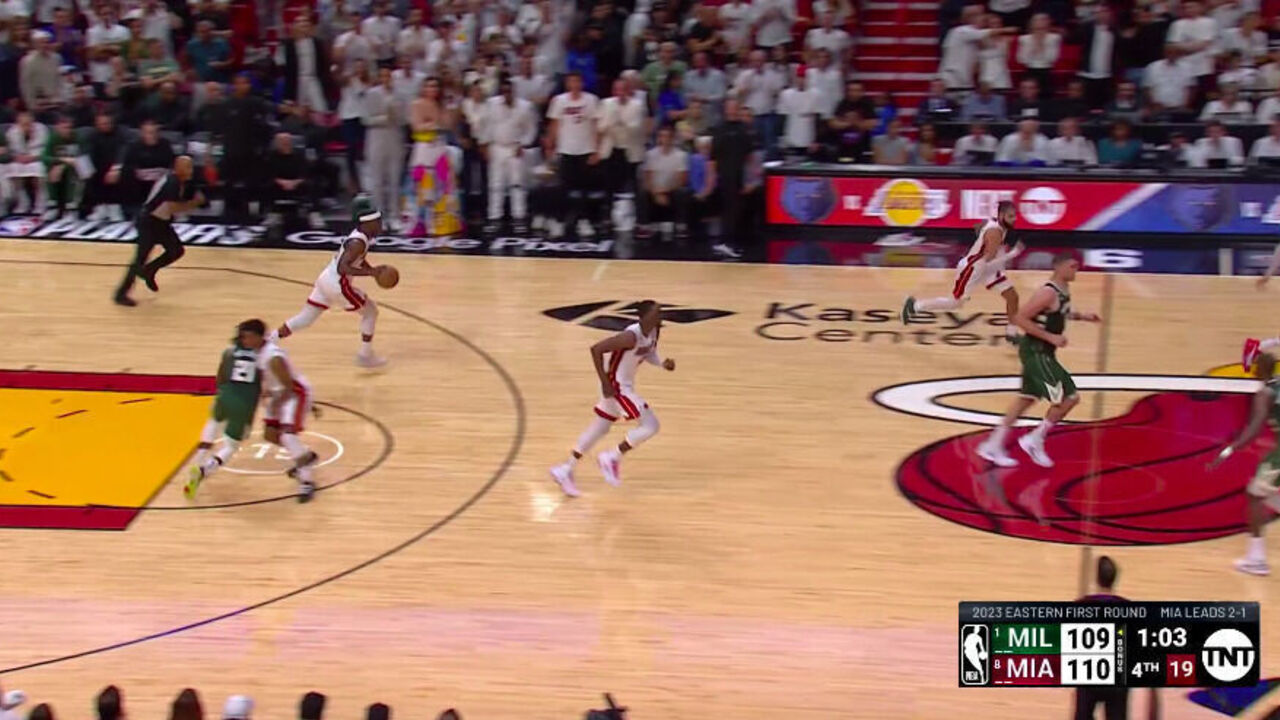
Milwaukee with a healthy Giannis is still the far superior team. It’s telling that even with Butler’s herculean effort in Game 4, the Heat had to claw back from a big deficit to win by one possession (before the foul game began). The Bucks are obviously in a precarious situation with zero margin for error, but if they tighten things up just a bit, they can absolutely come back and win this.
Grizzlies vs. Lakers
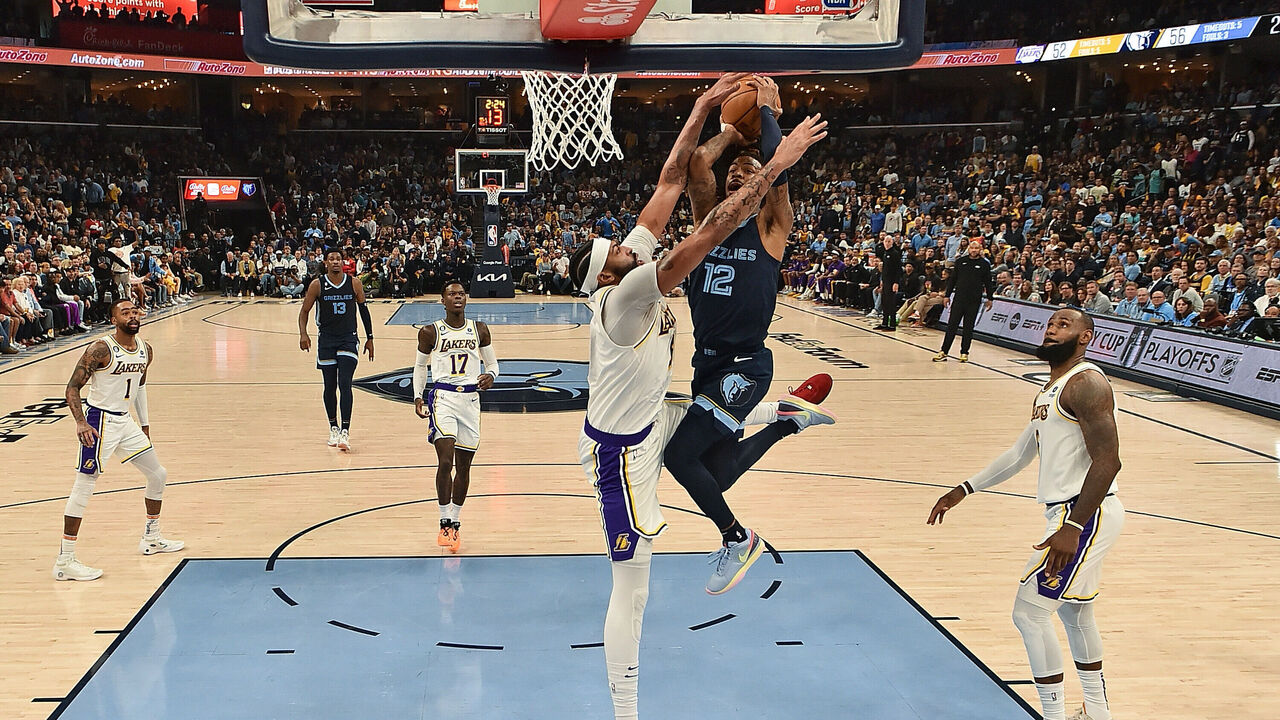
How we got here
The Grizzlies are really feeling their frontcourt absences and the resulting hit to their depth. They’ve missed Steven Adams’ offensive rebounding and space-clearing screens, as well as Brandon Clarke’s secondary rim protection and above-the-rim finishing. Without those guys, and with Ja Morant banged up, Memphis has been bottled up by Anthony Davis and a dialed-in Lakers defense.
That defense has smothered Memphis’ pick-and-roll game, as the Grizzlies have struggled to pull Davis away from the rim. They’ve scored just 0.72 points per possession on plays finished by a pick-and-roll ball-handler, dead last among playoff participants, per NBA Advanced Stats. Memphis as a team has shot just 57.8% inside the restricted area, which is second worst among playoff teams; that drops to 48.6% when Davis is in the vicinity.
While Davis has been the linchpin, protecting the paint has been a team-wide mandate for the Lakers. They’ve decided they’re fine with surrendering basically any jump shot to any Grizzly other than Desmond Bane or Luke Kennard if it means jamming up Morant’s driving lanes or swarming Jaren Jackson’s post-ups. They’ve been especially liberal helping off of Dillon Brooks, and his inability to make them pay has created a problem for Memphis not unlike Cleveland’s Isaac Okoro conundrum.
Brooks is the Grizzlies’ best individual defensive option on LeBron, and his ability to guard any other Lakers threat – from Davis to D’Angelo Russell to Austin Reaves – makes him something of a skeleton key when the Grizzlies want to lean on switching. But look at where Russell is planted while “guarding” Brooks in the far corner on this high pick-and-roll:
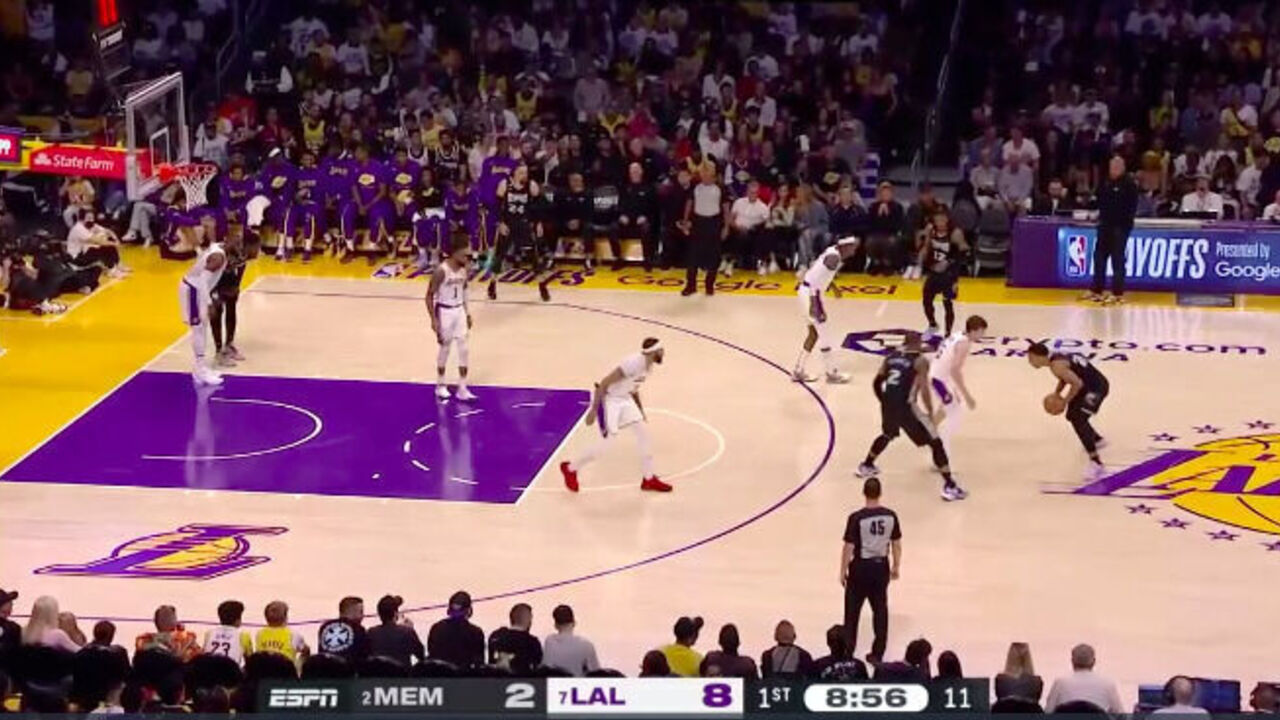
When the Grizzlies try to mitigate his lack of off-ball gravity by involving him directly in ball-screen action, the Lakers simply put two on the ball and consider it a win if it gets swung to Brooks above the break:

Things really open up for Memphis when Kennard’s on the floor (his 114.7 on-court offensive rating in the series is 7.3 points per 100 better than any other Grizzly), but it’s unclear if the team can survive defensively playing extended minutes with both him and Morant out there. As it is, the Lakers have had a lot of success running pick-and-rolls targeting Morant, especially double-drag actions that force him to defend the first screen and then navigate the second:
With LeBron and Davis both hobbled and unable to bring their usual level of offensive assertiveness, the Lakers’ supporting cast has really picked up the slack, especially Reaves and Rui Hachimura. But LeBron also showed in Game 4 that he can still dominate a game in the margins, snagging 20 rebounds (including five on the offensive glass), playing fearsome defense down the stretch, drawing two charges, and scoring the game-tying and game-icing buckets on tough driving layups.
Even at 38, with a foot injury that’s sapped his lift, it’s tough not to trust him to make enough winning plays at both ends to help L.A. close this out.
Can the Grizzlies come back?
It’d be easier to feel confident about this if Morant was fully healthy, but he fell hard on his already mangled right hand in Game 4 and was doing an awful lot of dribbling with his left thereafter. He still made some spectacular plays – including a huge lefty dunk and some wicked lay-down passes – but he shot 8-for-24 in the game and has had a hard time finishing in the paint this whole series. He’s hit just 25% from floater range, crippling one of Memphis’ most viable counters to drop coverage.
The good news is Bane finally shook loose against that drop in the second half of Game 4, as the Grizzlies started mixing in some Spain pick-and-roll to wipe Davis out of the action:
But more than anything, the fact that LeBron doesn’t quite look like LeBron is what gives the Grizzlies reason for optimism. He hasn’t been able to take over games as a scorer, he’s settled for a lot of threes and shot just 5-for-27 (18.5%) from deep, and he’s been alarmingly passive for long stretches throughout the series.
When running inverted pick-and-rolls to attack weaker defenders like Morant, he’s eschewed opportunities to turn the corner and drive to the rack. Instead, he’s looking to get off the ball early, even when minimal advantage is gained:
Can the Lakers score enough if both he and Davis continue to struggle offensively? Especially given that they have their own defensively vital space-clogger in Jarred Vanderbilt to scheme around? That puts a lot of pressure on L.A.’s secondary and tertiary creators. Russell has really struggled, and Hachimura has started to cool off.
Even with their injuries, the Grizzlies are the deeper team. They just need to play like it. (Eventually, Tyus Jones is going to have to make a three.) The Grizzlies have actually performed pretty well with their starters on the floor, so if their bench can outplay the Lakers’ from here on out, they’ll have a chance to turn this series around.

